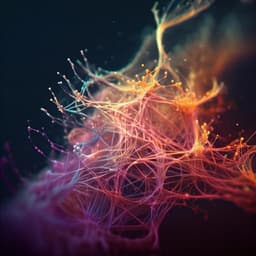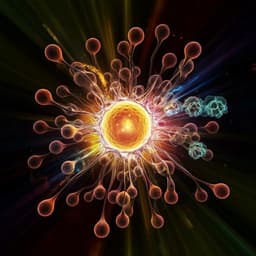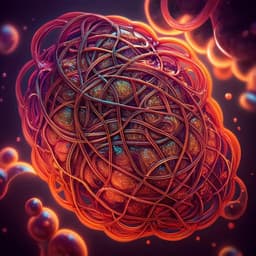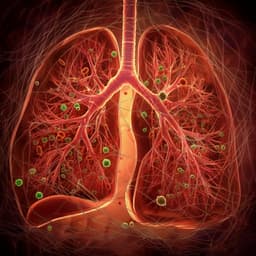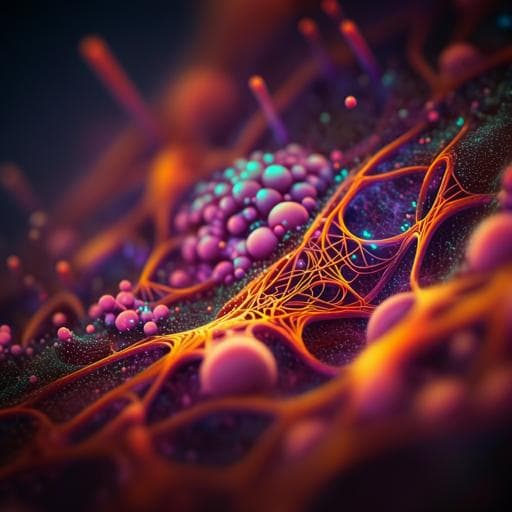
Medicine and Health
Neutrophil Extracellular Trap Formation: Physiology, Pathology, and Pharmacology
M. Ravindran, M. A. Khan, et al.
Explore the fascinating world of neutrophil extracellular traps (NETs) and their dual role in health and disease as researchers Mithunan Ravindran, Meraj A. Khan, and Nades Palaniyar unravel the complexities of NET formation and regulation. Discover how these immune responses can be both beneficial and pathogenic, potentially leading to groundbreaking therapeutics.
~3 min • Beginner • English
Introduction
This review addresses how neutrophil extracellular traps (NETs) form under different conditions and why this process matters for health and disease. The authors synthesize rapid advances in understanding Nox-dependent and Nox-independent NET formation, the emerging concept of vital NET release without cell death, and context-specific regulation (bloodstream vs tissue; alkaline vs hypertonic environments). They outline controversies (e.g., the role of PAD4 and histone citrullination in Nox-dependent NETs; the requirement for transcription) and aim to provide an updated, unified model of NET formation while discussing implications for diseases (atherosclerosis, autoimmunity, diabetes, cancer) and potential therapeutics (e.g., gasdermin D and transcription inhibitors, DNase).
Literature Review
The review traces the discovery of NETs from early observations of non-apoptotic, non-necrotic neutrophil death upon PMA stimulation to the identification of NETs as extracellular antibacterial structures. It differentiates suicidal NET release (typically 2–4 h after activation; classically Nox-dependent) from vital NET formation (5–60 min), including distinct forms: mitochondrial DNA release in response to GM-CSF plus LPS or C5a; platelet TLR4-dependent nuclear DNA release with Gram-negative bacteria; and nuclear blebbing induced by S. aureus toxins. It discusses autophagy’s role in NET formation, UV-induced ApoNETosis, and the evolving terminology advising against the blanket use of “NETosis” without evidence of cell death. The review summarizes complement activation on NETs (e.g., alternative pathway components on NETs, C5b-9 deposition), details mechanistic pathways for Nox-dependent NETs (PMA vs LPS/TLR4/JNK differences), and debates PAD4’s role with conflicting evidence. For Nox-independent NETs, it highlights calcium influx, PAD4-mediated histone citrullination, SK channels, and mitochondrial ROS. It introduces transcriptional firing at promoter regions as a facilitator of chromatin decondensation with context-dependent evidence. Histone modifications are covered, including citrullination, acetylation (promoting NETs), and the potential interplay with methylation. Physiological context effects include bloodstream vs tissue NET programs, pH’s bidirectional regulation (alkaline enhances; acidic suppresses), and suppression by hypertonic saline/osmolytes via ROS inhibition. NET clearance by DNase I and macrophage efferocytosis is summarized, including impairments in SLE and ARDS. Disease associations span immunodeficiency (CGD), autoimmunity (RA, SLE), diabetes complications (delayed wound healing), cardiovascular disease (atherosclerosis), cancer progression/metastasis, and cystic fibrosis airway pathology. Therapeutic avenues include restoring Nox in CGD, Nox inhibition limits, transcription inhibition, gasdermin D blockers (e.g., LDC7559), and DNase benefits/risks.
Methodology
This is a narrative review synthesizing published experimental and clinical studies on NET formation mechanisms, context dependence, disease associations, and therapeutic strategies. The article does not describe a systematic literature search strategy (e.g., databases, time frames, inclusion/exclusion criteria). Mechanistic descriptions and a unified model are compiled from prior primary research and reviews, supported by representative figures and referenced studies.
Key Findings
- NET formation comprises distinct mechanistic programs: Nox-dependent (e.g., PMA, LPS via TLR4/JNK) and Nox-independent (e.g., ionomycin/A23187 via calcium influx, PAD4 activation, mitochondrial ROS and SK channels). Suicidal NETs typically occur over 2–4 h; vital NETs can occur within 5–60 min and may release nuclear or mitochondrial DNA while preserving neutrophil functions.
- PAD4-mediated histone citrullination is essential for many Nox-independent NETs (e.g., A23187 induces CitH3), whereas its necessity in Nox-dependent NETs (PMA/LPS) remains controversial with conflicting mouse knockout and inhibitor data.
- Transcriptional firing at promoters facilitates chromatin decondensation and is proposed as required for both Nox-dependent and Nox-independent NETs in serum-free conditions; inhibition of transcription (but not translation) suppresses NETs without impairing antimicrobial ROS. Serum conditions may modulate this requirement.
- Histone modifications regulate NET chromatin: acetylation promotes NET formation (HDAC inhibitors enhance NETs at low dose and can switch death toward apoptosis at higher doses; e.g., belinostat 0–0.25 μM increases, >1 μM inhibits). Potential antagonism with arginine methylation is suggested.
- Physiological context strongly shapes NET programs: in the bloodstream, LPS triggers rapid, platelet-dependent, Nox-independent vital NETs; in tissues, LPS induces slower, suicidal, Nox-dependent NETs. NET responsiveness varies by LPS serotype between intravascular vs tissue settings.
- pH modulates NETs: alkaline pH enhances both Nox-dependent (increased ROS, histone cleavage) and Nox-independent NETs (increased intracellular pH, Ca2+, mROS, PAD4 activity); acidic pH suppresses NETs and glycolysis/ROS. Hypertonic saline and osmolytes suppress Nox-dependent NETs via ROS reduction, reversible with H2O2.
- Complement activates on NETs: neutrophils release AP components (C3, CFP, CFB), facilitating C3bBb formation and C5b-9 deposition on NETs; DNase disrupts this deposition.
- NET clearance depends on DNase I and macrophage endocytosis/efferocytosis; impairments associate with SLE nephritis and ARDS.
- Disease links: CGD (defective Nox-dependent NETs and infection susceptibility); RA (elevated spontaneous NETs, MPO-DNA remnants correlate with RF positivity); diabetes and chronic wounds (NETs, PAD4, NE associate with delayed healing; DNase accelerates healing in mice); atherosclerosis (cholesterol crystals induce Nox-dependent NETs; NETs license macrophages for IL-1β and TH17 activation; circulating chromatin associates with CAD severity); cancer (NET-bound NE and MMP-9 promote tumor growth; NETs capture circulating tumor cells and enhance metastasis); cystic fibrosis (airway NETs increase mucus viscosity and tissue damage; DNase benefits sputum clearance).
- Therapeutics: gene therapy restoring Nox rescues NETs and resolves refractory aspergillosis in CGD; DPI blocks Nox-dependent NETs but hampers neutrophil function; transcription inhibitors may block both NET programs while sparing ROS-dependent killing; gasdermin D is required for NETs and can be inhibited (e.g., LDC7559) without impairing phagocytosis/degranulation; DNase degrades extracellular NET DNA (beneficial in CF) but may release histones/proteases and disrupt beneficial NET aggregation in some contexts.
Discussion
The review integrates mechanistic and contextual insights to support a unified model where distinct ROS sources (Nox vs mitochondria), kinase cascades, transcriptional firing, and chromatin remodeling converge to enable chromatin decondensation and DNA extrusion, with gasdermin D facilitating granule permeabilization and NET release routes. Contextual cues (vascular vs tissue environment, pH, osmolality, pathogen molecules) channel neutrophils into specific NET programs, explaining divergent observations across studies and disease settings. These mechanistic distinctions clarify how NETs can be antimicrobial yet contribute to pathology (autoimmunity, thrombosis/atherosclerosis, cancer metastasis, impaired wound healing, CF airway damage). Therapeutically, selectively targeting NET formation (e.g., transcriptional blockade in specific contexts, gasdermin D inhibition) or enhancing clearance (DNase with caution) offers potential to mitigate disease while preserving essential neutrophil functions like phagocytosis and ROS-dependent killing. Ongoing controversies (PAD4 requirement in Nox-dependent NETs; transcription dependence under serum conditions) underscore the need for standardized experimental contexts and in vivo validation.
Conclusion
This review updates a unified model of NET formation by delineating Nox-dependent and Nox-independent mechanisms, vital vs suicidal NET programs, and key regulators (ROS sources, kinases, transcriptional firing, histone modifications, gasdermin D). It highlights strong context dependency (bloodstream vs tissue; pH; tonicity) and broad pathological implications across autoimmunity, diabetes and wound healing, cardiovascular disease, cancer, and CF. Promising interventions include selective inhibition of gasdermin D and transcriptional programs, context-aware use of DNase, and restoration of Nox in immunodeficiencies. Future work should resolve PAD4 and transcription controversies, define histone methylation’s role, standardize experimental conditions (pH, serum), expand in vivo models, and develop therapeutics that curb pathological NETs while preserving core neutrophil defenses.
Limitations
- As a narrative review, no systematic search methods are described, which may introduce selection bias.
- Several mechanistic conclusions rely on non-physiological agonists (e.g., PMA, calcium ionophores) and may not fully reflect in vivo biology.
- Key controversies remain unresolved (PAD4’s role in Nox-dependent NETs; necessity of transcription under different serum conditions).
- Contextual factors (pH, osmolarity, LPS serotypes) vary across studies and are not uniformly controlled, limiting cross-study comparability.
- Some proposed therapeutic strategies (e.g., transcription or gasdermin D inhibitors) require further validation for efficacy and safety in vivo.
- DNase therapy, while beneficial in some settings, may not clear histones/proteases and could exacerbate inflammation in certain diseases.
Related Publications
Explore these studies to deepen your understanding of the subject.



